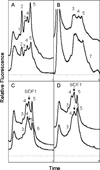Enhanced reductive dechlorination of polychlorinated biphenyl impacted sediment by bioaugmentation with a dehalorespiring bacterium
- PMID: 21902247
- PMCID: PMC3210572
- DOI: 10.1021/es201553c
Enhanced reductive dechlorination of polychlorinated biphenyl impacted sediment by bioaugmentation with a dehalorespiring bacterium
Abstract
Anaerobic reductive dehalogenation of commercial PCBs such as Aroclor 1260 has a critical role of transforming highly chlorinated congeners to less chlorinated congeners that are then susceptible to aerobic degradation. The efficacy of bioaugmentation with the dehalorespiring bacterium Dehalobium chlorocoercia DF1 was tested in 2-L laboratory mesocosms containing sediment contaminated with weathered Aroclor 1260 (1.3 ppm) from Baltimore Harbor, MD. Total penta- and higher chlorinated PCBs decreased by approximately 56% (by mass) in bioaugmented mesocosms after 120 days compared with no activity observed in unamended controls. Bioaugmentation with DF-1 enhanced the dechlorination of doubly flanked chlorines and stimulated the dechlorination of single flanked chlorines as a result of an apparent synergistic effect on the indigenous population. Addition of granulated activated carbon had a slight stimulatory effect indicating that anaerobic reductive dechlorination of PCBs at low concentrations was not inhibited by a high background of inorganic carbon that could affect bioavailability. The total number of dehalorespiring bacteria was reduced by approximately half after 60 days. However, a steady state level was maintained that was greater than the indigenous population of putative dehalorespiring bacteria in untreated sediments and DF1 was maintained within the indigenous population after 120 days. The results of this study demonstrate that bioaugmentation with dehalorespiring bacteria has a stimulatory effect on the dechlorination of weathered PCBs and supports the feasibility of using in situ bioaugmentation as an environmentally less invasive and lower cost alternate to dredging for treatment of PCB impacted sediments.
Figures




 ) and day 120 (■). Treatments included spent medium only, spent medium and GAC, amendment with DF-1 by direct injection, and amendment with DF-1 adsorbed to GAC. Each bar represents the mean and standard deviation of three replicates samples.
) and day 120 (■). Treatments included spent medium only, spent medium and GAC, amendment with DF-1 by direct injection, and amendment with DF-1 adsorbed to GAC. Each bar represents the mean and standard deviation of three replicates samples.
Similar articles
-
Remediation of polychlorinated biphenyl impacted sediment by concurrent bioaugmentation with anaerobic halorespiring and aerobic degrading bacteria.Environ Sci Technol. 2013 Apr 16;47(8):3807-15. doi: 10.1021/es304372t. Epub 2013 Mar 26. Environ Sci Technol. 2013. PMID: 23463900 Free PMC article.
-
Effects of bioaugmentation on indigenous PCB dechlorinating activity in sediment microcosms.Water Res. 2011 Jul;45(13):3899-907. doi: 10.1016/j.watres.2011.04.048. Epub 2011 May 4. Water Res. 2011. PMID: 21601905
-
Effects of activated carbon on reductive dechlorination of PCBs by organohalide respiring bacteria indigenous to sediments.Water Res. 2014 Apr 1;52:1-10. doi: 10.1016/j.watres.2013.12.030. Epub 2014 Jan 2. Water Res. 2014. PMID: 24440760
-
A case study for microbial biodegradation: anaerobic bacterial reductive dechlorination of polychlorinated biphenyls-from sediment to defined medium.Annu Rev Microbiol. 2008;62:253-70. doi: 10.1146/annurev.micro.62.081307.162733. Annu Rev Microbiol. 2008. PMID: 18729735 Review.
-
Microbial reductive dechlorination of PCBs.Biodegradation. 1993-1994;4(4):231-40. doi: 10.1007/BF00695971. Biodegradation. 1993. PMID: 7764920 Review.
Cited by
-
Plant-assisted rhizoremediation of decabromodiphenyl ether for e-waste recycling area soil of Taizhou, China.Environ Sci Pollut Res Int. 2015 Jul;22(13):9976-88. doi: 10.1007/s11356-015-4179-2. Epub 2015 Feb 11. Environ Sci Pollut Res Int. 2015. PMID: 25666473
-
Metagenomic applications in environmental monitoring and bioremediation.J Ind Microbiol Biotechnol. 2016 Oct;43(10):1345-54. doi: 10.1007/s10295-016-1809-8. Epub 2016 Aug 24. J Ind Microbiol Biotechnol. 2016. PMID: 27558781 Review.
-
Enhanced reductive dechlorination of polychlorinated biphenyl-contaminated soil by in-vessel anaerobic composting with zero-valent iron.Environ Sci Pollut Res Int. 2014 Mar;21(6):4783-92. doi: 10.1007/s11356-013-2420-4. Epub 2013 Dec 22. Environ Sci Pollut Res Int. 2014. PMID: 24363050
-
Enhanced Polychlorinated Biphenyl Removal in a Switchgrass Rhizosphere by Bioaugmentation with Burkholderia xenovorans LB400.Ecol Eng. 2014 Oct 1;71:215-222. doi: 10.1016/j.ecoleng.2014.07.046. Ecol Eng. 2014. PMID: 25246731 Free PMC article.
-
Burning question: Rethinking organohalide degradation strategy for bioremediation applications.Microb Biotechnol. 2024 Aug;17(8):e14539. doi: 10.1111/1751-7915.14539. Microb Biotechnol. 2024. PMID: 39075849 Free PMC article. Review.
References
-
- Alder AC, Häggblom MM, Oppenheimer SR, Young LY. Reductive dechlorination of polychlorinated biphenyls in anaerobic sediments. Environ. Sci. Technol. 1993;27:530–538.
-
- Versar I. PCBs in the United States: industrial use and environmental distribution. 1976 EPA report 560/6-76-005.
Publication types
MeSH terms
Substances
Grants and funding
LinkOut - more resources
Full Text Sources
Other Literature Sources
Miscellaneous

